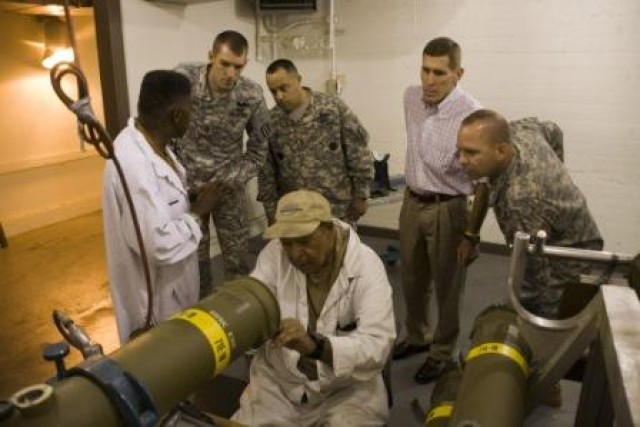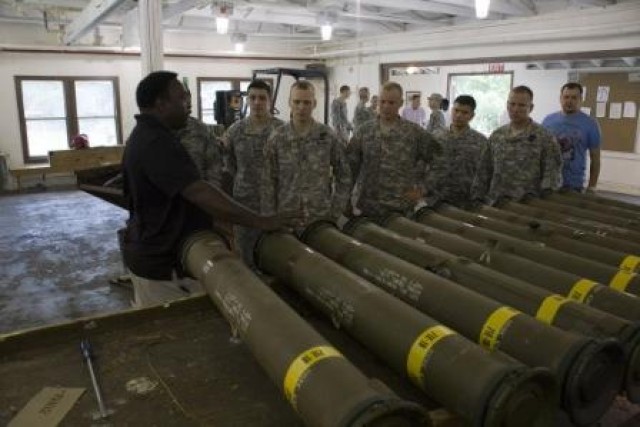ANNISTON ARMY DEPOT, Ala.-Eight Soldiers from Fort Benning, Ga., visited Anniston Defense Munitions Center Aug. 20 to see the inner workings of the TOW (Tube-Launched, Optically-tracked, Wire-guided) missile, something few will ever get the chance to see.
The Soldiers, who are all non-commissioned officer instructors in the Ft. Benning-based Heavy Weapons Leadership Course, were accompanied by the TRADOC Capability Manager (IBCT/CCMS) and a representative from the TOW missile PM office. They received a tour through the ADMC Missile Recycling Center and a TOW missile maintenance line.
The visit gave the Soldiers a chance to see the TOW missile "HEAT to Practice" operation, which transforms a fully operational High Explosive Anti-Tank TOW missile into a practice round. The instructors were especially interested in this process, since the newly converted missiles will be sent to the HWLC where they will be used in the training of war fighters attending the two-week course.
"This will definitely help us to teach more efficiently by being more knowledgeable about the components and the functionality of these components," said Sgt. Christopher Dennis, one of the visiting instructors.
The Soldiers saw how old and expired missiles are dismantled and some parts re-used for newer missile systems. They were also briefed on the recycling process and the measures taken by ADMC to mitigate negative environmental impact of missile destruction.
The Soldiers' mission as instructors at the HWLC is to teach their student Soldiers how to identify and properly operate a wide variety of small and heavy weapons, ranging from the M16 rifle to the .50 caliber machine gun and several anti-tank/anti-armor missiles including the TOW and the Improved Target Acquisition System.
In order to qualify for selection as a student at the HWLC, one must attain the rank of specialist through first sergeant or for commissioned officers the ranks of lieutenant and captain and be in the MOS of 11B (Infantry) or 19D (Cavalry Scout). The course was developed after the Department of the Army recognized a need for Soldiers in these specialties to have a greater understanding of the mentioned weapons systems and the need for this knowledge on the battlefield.
"This information will help us as instructors better understand the weapon, and in turn help us to better train the Soldier to perform effectively on the battlefield," said Sgt. 1st Class Randall Jacobsen.
ADMC's MRC is the first and only missile recycling facility in the U.S. Army. It is an operation that focuses on re-utilizing all components of an expired or obsolete missile system. The MRC began operations in 2003 and to-date has recycled more than 60,000 TOW missiles.
The environmentally-sound practices of the MRC have already proven to be a great asset to the Army's efforts to minimize environmental hazards while disposing of munitions. Disposing of missiles in this manner greatly reduces the amount of waste introduced into the environment as compared to the open burn/open detonation method. The MRC also recapitalizes valuable assets by returning recovered missile parts to the manufacturers for use in new missile production. This has resulted in a savings of tens of millions of dollars over the past six years.
In addition to the Missile Recycling Center, ADMC also has a missile maintenance line that modifies and maintains the missile stockpiles for the Army, Navy and Air Force. The mission there is now focused on the TOW "HEAT to Practice" operation that brought the Soldiers to Anniston. The conversion of fully-functional TOW missiles into training missiles has seen a production rise from roughly 15 missiles per day a year ago to about 35 per day at present.
"The goal is to be able to convert at least 50 missiles per day," said Clyde Hill, ADMC maintenance line supervisor. The maintenance line also plays a big part in the environmentally friendly atmosphere at ADMC. The maintenance line also recycles or re-uses all of the salvageable or recyclable materials during the missile conversion. This also saves the government money by using the missile as a training round before the shelf life expires, which means the missile would have to be destroyed by a more costly and less environmentally-'friendly method.
"This was an invaluable visit that helped our heavy weapons instructors understand the internal workings and gain confidence in the missiles they launch during training and on the battlefield," Lt. Col. Duncan Macmullen. "The ADMC team also benefited from the visit by getting direct positive feedback from our customers, the warfighter."
ADMC leadership is planning a visit to Ft. Benning to see the operational side of the work done here at the Missile Recycling Center and on the missile maintenance line. This type of life cycle awareness helps the ADMC team maintain its status as DoD's ammunition experts by keeping abreast of the Soldiers' requirements.




Social Sharing